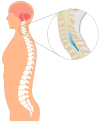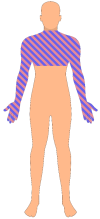Orthopedic Manifestations of Syringomyelia: A Comprehensive Review
- PMID: 40364175
- PMCID: PMC12072671
- DOI: 10.3390/jcm14093145
Orthopedic Manifestations of Syringomyelia: A Comprehensive Review
Abstract
Background: Syringomyelia is a complex neurological disorder characterized by a fluid-filled cavity (syrinx) within the spinal cord, frequently resulting from altered cerebrospinal fluid (CSF) dynamics. While its clinical manifestations are diverse, orthopedic complications such as scoliosis, pes cavus, and Charcot arthropathy may represent early diagnostic clues yet are often under-recognized. Methods: This comprehensive review synthesizes the current literature on the pathophysiology, clinical presentation, diagnostic strategies, and management approaches of syringomyelia, with a specific emphasis on its orthopedic manifestations. Additionally, we present a detailed case of neuropathic shoulder arthropathy associated with advanced syringomyelia. Results: Orthopedic involvement in syringomyelia includes progressive spinal deformities and neurogenic joint destruction, particularly affecting the shoulder and elbow. Scoliosis is frequently observed, especially in association with Chiari malformations, and may precede neurologic diagnosis. Charcot joints result from impaired proprioception and protective sensation. The case presented illustrates the diagnostic challenges and therapeutic dilemmas in managing advanced neuro-orthopedic complications in syringomyelia. Conclusions: Syringomyelia should be considered in the differential diagnosis of atypical musculoskeletal presentations. Early recognition and multidisciplinary management are essential to prevent irreversible orthopedic sequelae. Conservative treatment remains the mainstay in stable cases, while surgery is reserved for progressive disease. Orthopedic assessment plays a pivotal role in the diagnostic pathway and long-term care of affected patients.
Keywords: Charcot joint; Chiari malformation; cerebrospinal fluid; neurogenic arthropathy; neuropathic pain; orthopedic procedures; scoliosis; spasticity; spinal cord diseases; syringomyelia.
Conflict of interest statement
The authors declare no conflicts of interest.
Figures






References
-
- Sabellano Z., Batino L., Navarro J.J. Atypical presentation of syringomyelia mimicking as motor neuron disease: A case report. Clin. Imag. Med. Case Rep. 2023;4:2685. doi: 10.52768/2766-7820/2685. - DOI
Publication types
LinkOut - more resources
Full Text Sources

